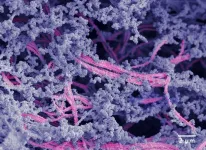(Press-News.org) August 4, 2024-- Drug-involved overdose deaths increased by over 500 percent in 2022 according to a study at Columbia University Mailman School of Public Health, with trends attributed to synthetic opioids. National data shows that fentanyl and heroin in particular attributed substantially to the rise particularly since 2014. However, the study also reports that income protection policies, can have a supportive role in preventing fatal drug overdoses. The findings are reported in the International Journal of Drug Policy.
Over 73,000 people died from an overdose in 2020, which subsequently increased to 106,699 people in 2021, a record for the highest number of overdose deaths in one year.
“And in fact, more recently, we entered a fourth wave of the overdose crisis, characterized by fatal overdoses in the context of polysubstance use,” says Silvia Martins, MD, PhD, professor of Epidemiology at Columbia Public Health.
The COVID-19 pandemic exacerbated economic hardship; and as a result, the U.S, government enacted income protection programs in conjunction with existing unemployment insurance (UI) to dampen COVID-19-related economic consequences.
“In the context of financial and economic stressors which are known to increase overdose risk we hypothesized that we would observe lower levels of overall overdose and opioid deaths given that robust unemployment insurance benefits could be a buffer,” said Martins., who is also director of the Substance Use Epidemiology Unit of the Department of Epidemiology at Columbia.
The researchers used data based on responses of 89,914 individuals 18 years of age or older from the pooled 2014 – 2020 Detailed Restricted Mortality files for all counties from the Centers for Disease Control and Prevention, aggregating at the county-quarter level. Included were deaths from any drug overdose, any opioid overdose, and any stimulant overdose. Data on unemployment insurance were obtained from the U.S. Department of Labor as well as statutes by the individual states.
Data from 30 states collected by the CDC indicate rates were persistently stable or even increasing, suggesting that increases in overdose deaths observed after the start of the pandemic show minimal signs of abating. “In fact, treatment disruptions and closures of harm reduction organizations in compliance with social distancing ordinances may have also contributed to worsening substance use morbidity and mortality during this period,” noted Martins.
“We also theorized that states and counties with limited safety net policies may increase an individual’s social, psychological, and biological vulnerability to develop a drug use disorder, including opioid and stimulant use disorders. Such policies likely play a significant role in substance use initiation and subsequent development of substance use disorders as well as treatment access for such disorders,” Martins noted.
For the entire study period of 2014 to 2020 a more robust weekly benefit replacement rate[s1] was inversely associated with fewer fatal overdoses from any drug, including fatal opioid and stimulant overdoses. A replacement of income with a more robust weekly benefit allowance rate was associated with fewer fatal drug, opioid and stimulant overdoses in the pre-COVID-19 period and with fewer fatal any drug and stimulant overdoses in the COVID-19 period.
An earlier study that examined the relationship between state-level UI robustness and fatal opioid overdoses from 1999 to 2012 support the current findings although the research used data from earlier in the overdose epidemic and also different methods were used.
“While their earlier analysis shows that, between 1999 to 2012, UI was associated with lower rates of opioid overdoses, our study builds and expands on findings from that research, as we examined the relationship between UI and any drug-involved mortality -- including all other drug overdoses and stimulant overdoses -- during the 4th wave of the epidemic intertwined with the COVID-19 period,” observed Martins. In addition, the earlier study only examined fatal overdoses among “prime-age” people aged 25-54, whereas Martins and her team expanded our inclusion criteria to include everyone ages 18 and older.
“Our results therefore reinforce the notion in a call for a broader discussion on the protective role of the safety net programs to buffer drug-related harms,” stated Martins.
Co-authors are Luis E. Segura, Megan E. Marziali, Emilie Bruzelius, Natalie S. Levy, Sarah Gutkind, and Kristen Santarin, Columbia Mailman School of Public Health; Katherine Sacks, Milken Institute; and Ashley Fox, University at Albany, SUNY.
The study was funded by the Columbia University Mailman School of Public Health Calderone Health Equity Award and NIH-NIDA grants R01DA059376 and T32DA031099.
Columbia University Mailman School of Public Health
Founded in 1922, the Columbia University Mailman School of Public Health pursues an agenda of research, education, and service to address the critical and complex public health issues affecting New Yorkers, the nation and the world. The Columbia Mailman School is the fourth largest recipient of NIH grants among schools of public health. Its nearly 300 multi-disciplinary faculty members work in more than 100 countries around the world, addressing such issues as preventing infectious and chronic diseases, environmental health, maternal and child health, health policy, climate change and health, and public health preparedness. It is a leader in public health education with more than 1,300 graduate students from 55 nations pursuing a variety of master’s and doctoral degree programs. The Columbia Mailman School is also home to numerous world-renowned research centers, including ICAP and the Center for Infection and Immunity. For more information, please visit www.mailman.columbia.edu.
END
Could This New Drug Turn Back the Clock on Multiple Sclerosis?
Ten years of work, and a little help from the green mamba snake, has resulted in a promising new drug that is already being tested in clinical trials.
Multiple sclerosis (MS) degrades the protective insulation around nerve cells, leaving their axons, which carry electrical impulses, exposed like bare wires. This can cause devastating problems with movement, balance and vision; and without treatment, it can lead to paralysis, loss of independence and a shortened lifespan.
Now, scientists at UC San Francisco and Contineum Therapeutics have developed a drug that spurs the body to replace the lost insulation, ...
The story of Greenland keeps getting greener—and scarier.
A new study provides the first direct evidence that the center—not just the edges—of Greenland’s ice sheet melted away in the recent geological past and the now-ice-covered island was then home to a green, tundra landscape.
A team of scientists re-examined a few inches of sediment from the bottom of a two-mile-deep ice core extracted at the very center of Greenland in 1993—and held for 30 years in a Colorado storage facility. They were amazed to discover ...
Northwestern University scientists have developed a new bioactive material that successfully regenerated high-quality cartilage in the knee joints of a large-animal model.
Although it looks like a rubbery goo, the material is actually a complex network of molecular components, which work together to mimic cartilage’s natural environment in the body.
In the new study, the researchers applied the material to damaged cartilage in the animals’ knee joints. Within just six months, the researchers observed evidence of enhanced repair, including ...
ITHACA, N.Y. – A study of horses – which share many important similarities with humans in their chromosomes and pregnancies – revealed that 42% of miscarriages and spontaneous abortions in the first two months of pregnancy were due to complications from an extra set of chromosomes, a condition called triploidy.
“Over that embryonic period [up to eight weeks from conception], triploidy had rarely been reported in mammals outside of women,” said Mandi de Mestre, professor of equine medicine at Cornell University. “The study tells us that over the first six weeks ...
The Pyramid of Djoser, the oldest of Egypt’s iconic pyramids, may have been built with the help of a unique hydraulic lift system, according to a study published August 5, 2024, in the open-access journal PLOS ONE by Xavier Landreau from CEA Paleotechnic Institute, France, and colleagues. The new study suggests that water may have been able to flow into two shafts located inside the pyramid itself, where that water could have been used to help raise and lower a float used to carry the building stones.
The Pyramid of Djoser, also known as the Step Pyramid, is believed ...
URBANA, Ill. – If you enjoy a bowl of plain yogurt in the morning, adding a spoonful of honey is a delicious way to sweeten your favorite breakfast food. It also supports the probiotic cultures in the popular fermented dairy product, according to two new studies from the University of Illinois Urbana-Champaign.
“We were interested in the culinary pairing of yogurt and honey, which is common in the Mediterranean diet, and how it impacts the gastrointestinal microbiome,” said Hannah Holscher, associate professor in the Department of Food ...
Few communities reveal both the challenges and opportunities presented by cultural globalism more than Maasai communities in northern Tanzania. Traditionally pastoralists, the Maasai ethnic group’s social structure is historically patriarchal, with a man’s prestige measured by the size of his family and by the livestock he owns.
The shrinking world has brought change: Urban centers and the promise of jobs are luring young Maasai from communities, and new technologies such as mobile phones are shifting social patterns and structures that ...
NEW ORLEANS, La. – Ochsner Health proudly announces that 21 Ochsner nurses have been named to the 2024 Great 100 Nurses of Louisiana list by the Great 100 Nurses Foundation. This recognition highlights the contributions and commitment to excellence demonstrated by Ochsner’s nursing staff.
The Great 100 Nurses Foundation was established to honor nurses in Louisiana, North Carolina, Texas and Oklahoma. Each year, the foundation selects 100 nurses throughout Louisiana based on their concern for humanity, ...
(MEMPHIS, Tenn. – August 5, 2024) Chimeric antigen receptor (CAR) T–cell immunotherapy re-engineers a patient’s immune cells to target cancer cells. While successful in some types of leukemia, the approach has yet to realize its potential against pediatric solid tumors. Scientists at St. Jude Children’s Research Hospital have identified a way to improve CAR T–cell homing – a T cell’s ability to navigate effectively to a tumor – for osteosarcoma. Improved homing is a necessary step in designing more successful CAR T–cell therapies. The results were published today in Clinical Cancer ...
In Brazil, climate and other human-made environmental changes threaten decades-long efforts to fight a widespread and debilitating parasitic disease. Now, a partnership between researchers from Stanford and Brazil is helping to proactively predict these impacts.
Schistosomiasis, spread by freshwater snails, affects more than 200 million people in many tropical regions of the world. It can cause stomach pain and irreversible consequences such as enlarged liver and cancer. Public health officials worry that deforestation, rapid urban sprawl, and changing rainfall patterns – such as ...




